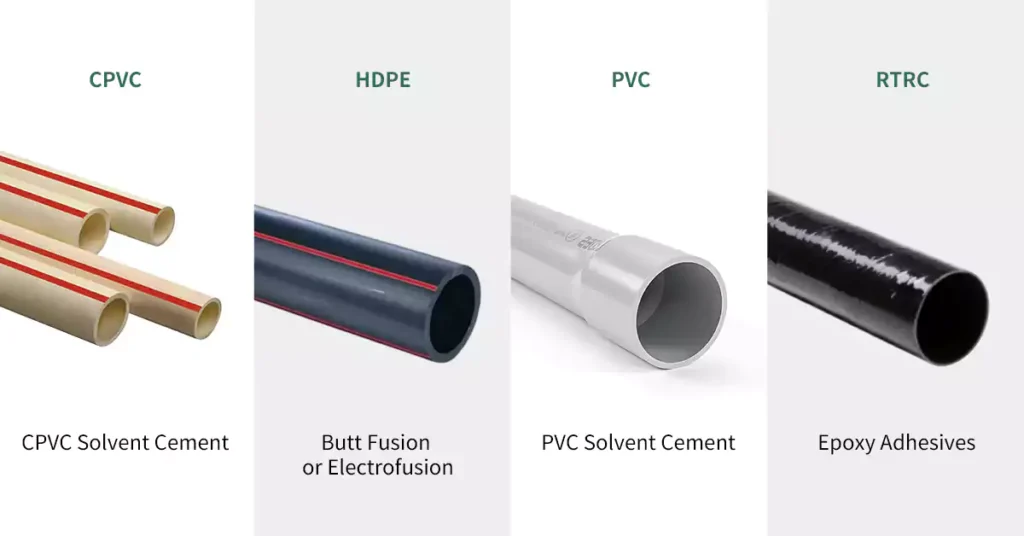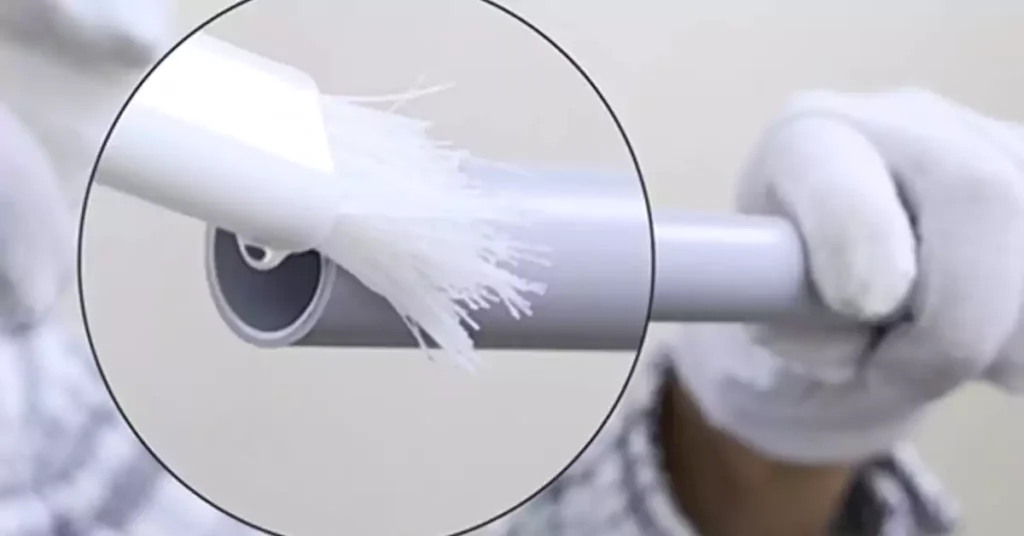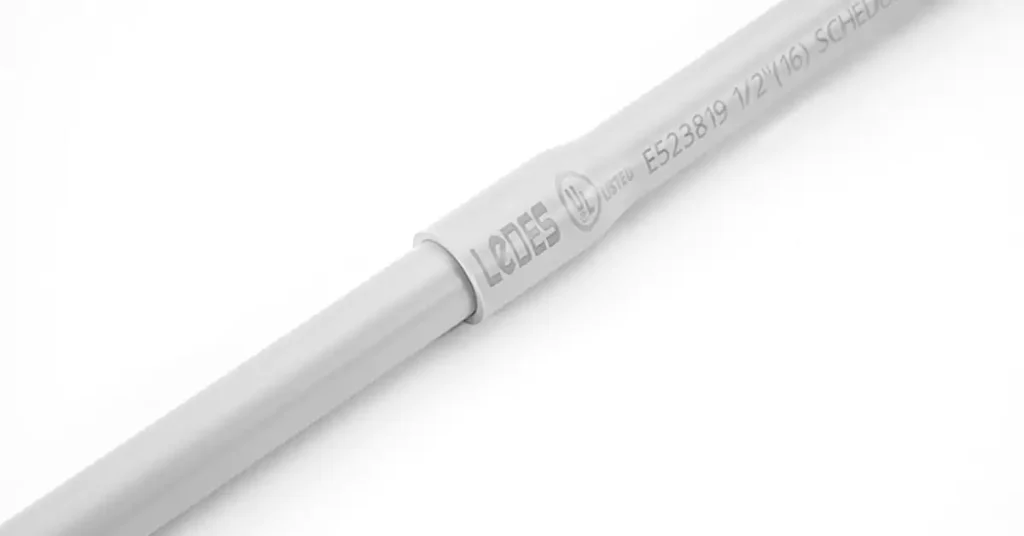
目录
正确连接电线导管是任何安全可靠的电气装置的关键组成部分。. 电气导管 导管作为电线的保护通道,可以屏蔽电缆免受潮气、机械损伤、化学物质侵蚀和其他环境因素的影响。如果导管接头连接或密封不当,整个系统就会变得脆弱,可能导致进水、腐蚀、绝缘失效、触电危险,甚至火灾。.
对于非金属导管,特别是PVC(聚氯乙烯)导管,人们通常使用“粘合”一词,但实际工艺要复杂得多。这种工艺被称为溶剂焊接,它是一种化学熔合,通过溶解和重塑塑料表面,将导管各段永久连接起来。如果操作得当,溶剂焊接可以形成水密、气密且结构强度高的接头,这对于地下和地上应用都至关重要。.
无论你是进行小型项目的 DIY 爱好者、学习基础知识的学徒,还是遵循严格规范要求的经验丰富的电工,了解如何正确粘合导管对于安全耐用的电气安装都至关重要。.
这本2025年权威指南提供了一套全面、循序渐进的PVC及其他塑料电线导管粘合方法。您将学习到:
- 哪些类型的电线导管设计用于粘合?
- PVC导管胶与其他粘合剂的区别
- 底漆在溶剂焊接中的关键作用
- 如何正确粘合导管——从准备、涂抹到固化
- NEC、CEC 和 AS/NZS 3000 布线规则中的重要规范要求
- 常见错误及避免方法
- 确保性能持久稳定的安全提示
无论您是安装住宅布线、工业系统还是太阳能和数据网络的导管,本指南都能确保每个粘合接头在 2025 年及以后都符合最高的耐用性、安全性和规范合规性标准。.
电线导管材料及配套粘合剂

在开始粘合导管之前,必须了解哪些类型的电线导管适合使用粘合剂进行粘合,以及哪种粘合剂技术效果最佳。不同的导管材料需要不同的连接方法,适用于塑料的粘合剂可能不适用于金属,反之亦然。选择正确的粘合剂不仅可以确保机械强度,还能保证安全性和符合规范。.
适合粘合的电线导管类型
电线导管由不同的材料制成,每种材料都有其特定的连接要求。有些材料可以通过化学熔接连接;而另一些材料则必须通过机械连接连接。下面我们来详细了解一下:
硬质 PVC 导管
硬质PVC导管 是业内最常用的胶粘式导管。它由聚氯乙烯制成,广泛用于住宅、商业和工业电气系统。主要优点包括:
- 耐腐蚀
- 非导电特性
- 紫外线稳定性和耐候性(具有相应的等级)
- 提供不同壁厚的 Schedule 40 和 Schedule 80 规格,以及其他类型的硬质 PVC 导管。.
连接方式: PVC导管采用溶剂型胶粘剂连接,这种胶粘剂通过化学作用将导管和配件熔合为一体。尤其是在符合规范的安装中,涂抹胶粘剂前需要先涂底漆软化表面。.
常见应用场景: 地下布线、明装室外线路、混凝土包裹的安装以及潮湿场所。.
CPVC导管
氯化聚氯乙烯(CPVC)导管 它与PVC管材类似,但设计用于承受更高的温度和更强的腐蚀性化学品。.
- 较高的热稳定性使其适用于工业环境。.
- 常用于高温或耐化学腐蚀的应用场合。.
连接方式: 使用CPVC专用溶剂型胶粘剂,通常为橙色或黄色。大多数安装都需要底漆。.
玻璃纤维导管(RTRC - 增强型热固性树脂导管)
玻璃纤维导管重量轻、阻燃、防腐蚀,并且在很宽的温度范围内都保持稳定。.
- 适用于腐蚀性、潮湿或工业环境
- 它不像塑料那样遇热变形。
连接方式: 不适用于溶剂焊接。它使用双组分环氧树脂粘合剂。粘合前必须清洁表面,通常还需要打磨。.
HDPE导管(高密度聚乙烯)
HDPE 是一种柔韧耐用的塑料导管,主要用于地下和非开挖安装。.
- 耐化学腐蚀、抗冲击和抗环境应力开裂
- 可制成长卷,最大限度减少接头。
连接与焊接: 最常用于大型安装(例如,对接熔接或电熔接)
⚠ENT(电气非金属管)
耳鼻喉 是一种轻质波纹塑料导管,用于墙壁和天花板。.
- 通常采用卡扣式或机械式连接方式连接。
❌ 金属导管(EMT、IMC、RMC)
电气金属导管 (EMT)、中间金属导管 (IMC) 和刚性金属导管 (RMC) 绝不使用胶粘剂。这些系统依靠以下方式连接:
- 螺纹式或压紧式接头
- 机械锁定系统
- 用于接地的连续导电性
选择合适的粘合剂
为确保连接安全持久,请考虑以下因素:
- PVC: 使用专为PVC配制的溶剂型胶粘剂。
- CPVC: 使用CPVC级溶剂胶
- 玻璃纤维: 使用双组分环氧树脂体系
- 高密度聚乙烯: 使用专用粘合剂(例如,BonDuit)
如果使用错误的胶水类型,例如将 PVC 胶水涂抹在 HDPE 上,不仅会造成接缝强度不足,而且根本无法粘合。.
导管粘合剂兼容性
导管类型 | 材料 | 连接方法 | 粘合剂类型 |
硬质 PVC | 塑料 | 溶剂焊接 | PVC胶水 |
氯乙烯 | 塑料 | 溶剂焊接 | CPVC水泥 |
玻璃纤维(RTRC) | 合成的 | 环氧树脂粘合剂 | 双组分环氧树脂 |
高密度聚乙烯 | 塑料 | 熔接/粘合 | 融合 |
柔性PVC(ENT) | 塑料 | 卡扣式或机械式配件 | 不适用 |
急救医疗技术员/中级医疗技术员/注册医疗技术员 | 金属 | 螺纹/压缩 | 不适用 |
溶剂焊接与粘合剂粘接

连接塑料导管时,常用的方法有两种:溶剂焊接和粘合剂粘接。乍看之下,这两种方法似乎很相似,但其工作原理却截然不同,选择正确的方法对于确保连接安全持久至关重要。.
溶剂焊接——一种化学熔合工艺
溶剂焊接主要用于PVC和CPVC导管系统。它不依赖粘合剂,而是使用溶剂型胶粘剂,通过化学作用软化并溶解导管和管件的表面。压合后,材料熔化并融合为一体。随着溶剂挥发,两部分形成永久性的分子键合连接,本质上是一种“冷焊”。”
- 这种连接与导管本身一样牢固。
- 接缝处防水且永久固定。
- 常见于管道和电气管道系统中
溶剂焊接接头一旦固化就无法拉开,必须切割才能拆卸。.
粘合剂粘接——一种表面粘接工艺
当溶剂焊接不可行时,例如玻璃纤维(RTRC)或高密度聚乙烯(HDPE)导管,则采用粘接连接。这种方法不是熔合基材,而是使用一层粘合剂(例如环氧树脂或树脂)粘附在每个部件的表面。.
- 接合处仍由两块独立的部件通过粘合剂粘合在一起。
- 适用于不与溶剂发生反应的材料
- 需要进行适当的表面清洁或准备。
虽然粘合接头不如溶剂焊接接头那样牢固,但正确使用的粘合剂可以具有结构强度和防水性,尤其是在使用专为导管类型设计的材料时。.
确保接合处完整性的必要预粘合准备工作——6 个技巧
在涂抹任何溶剂型胶粘剂之前,导管粘接成功的关键在于充分的准备工作。忽略或草率完成这些步骤是导致接头失效、泄漏和违反规范的主要原因之一。无论您使用的是硬质PVC、CPVC还是其他可溶剂焊接的导管,接头的完整性都取决于准备工作的完成情况,其重要性不亚于粘合剂本身。.
安全注意事项
用于导管安装的溶剂型胶粘剂和底漆含有易燃、快速挥发的化学物质。这些化学物质是溶剂焊接所必需的,但如果使用时未采取适当的预防措施,则会带来风险。.
为了保护您自己和工地上其他人的安全,请务必遵守以下基本安全操作规程:
穿戴个人防护装备(PPE):
手套: 使用耐化学腐蚀手套,避免皮肤刺激或吸收化学物质。.
眼部保护: 务必佩戴安全护目镜或面罩,以防止液体溅入眼睛。.
长袖和长裤: 避免皮肤直接接触溶剂和粘合剂。.
在通风良好的区域工作:
仅在通风良好的区域使用水泥和底漆,以驱散烟雾并降低吸入风险。.
对于封闭空间(例如,爬行空间、地下室、隧道),可考虑使用机械通风或便携式排烟器。.
吸入高浓度溶剂蒸汽会导致头晕、头痛、恶心或长期健康问题。切勿在不通风的密闭空间内使用敞开的底漆或胶水罐。.
火灾和点火隐患:
使所有底漆和水泥远离明火、火花或高温表面。.
将化学品存放在合格的容器中,远离热源。.
请勿在施工区域附近吸烟。.
将导管切割成方形并清理干净
正确的切割是确保接头牢固连接的基础。如果导管末端参差不齐、凹凸不平或呈角度,则粘合面无法均匀贴合,导致溶剂焊接不均匀。.
- 使用专为该材料设计的PVC棘轮切割器、细齿锯或导管切割器。.
- 确保切口与导管长度方向垂直(成直角)。斜切会减少粘合面积并产生应力集中点。.
- 请勿使用粗糙或磨损的工具,以免留下毛刺或熔化导管边缘。这样做会影响表面质量和安装效果。.
导管端面去毛刺和倒角
切割完成后,下一步是去毛刺。去除锋利或参差不齐的边缘,并可选择将外边缘倒角,以利于插入和溶剂分布。.
去毛刺:
使用去毛刺工具、美工刀或锉刀将导管的内边缘和外边缘打磨光滑。.
这样可以减少组装过程中的摩擦,并防止刨花干扰化学粘合过程。.
倒角或斜角加工:
对于直径为 2 英寸及以上的导管,强烈建议将导管外唇倒角 15°–30°。.
这样有助于均匀分布水泥,防止“回弹”,即在插入过程中将湿水泥刮掉。.
进行接头干装以确保正确对齐
在涂抹任何底漆或胶水之前,应先对导管和配件进行试装,以确保正确对齐和安装。.
如何进行干式试穿:
将导管完全插入接头中,无需使用水泥。.
它应该紧密贴合,阻力最小,但仍然可以用手推动。.
确保插入深度达到接头的内部止点。.
如果接合处过松或过紧,请重新检查其圆度、清洁度或制造公差。过松会导致粘合力弱;过紧则可能在组装过程中刮掉粘合剂。.
清洁粘合表面
即使是少量的灰尘、油污或水分也会干扰溶剂焊接过程中的化学熔合。因此,导管和接头表面都必须保持清洁干燥。.
- 用干净、不起毛的抹布或纸巾擦拭接合面。.
- 对于沾有油污或被污染的导管,请使用 PVC 清洁剂或变性酒精(不要使用丙酮)去除油脂或残留物。.
- 在涂底漆或水泥之前,请确保表面完全干燥。.
请勿尝试粘合潮湿或明显脏污的导管。这样做会导致接头不牢固、起泡或不完整。.
引物的作用
对于大多数溶剂焊接系统,特别是PVC和CPVC,底漆在确保化学熔合方面起着至关重要的作用:
- 软化塑料表面
- 打开材料孔隙,使溶剂能够渗透
- 清除清洁过程中遗漏的残留污染物
如何使用妆前乳:
使用经认可的底漆涂抹器(通常附在盖子上)涂满导管和接头插座的整个配合面。.
涂抹均匀,完全覆盖,并略微超出水泥涂抹区域。.
涂抹水泥前,请等待几秒钟,让底漆软化材料。.
请查看是否有颜色编码的底漆(例如紫色)以进行目测确认。许多地区都要求在电气和管道安装中使用底漆。.
电线导管粘合步骤详解

选好合适的粘合剂并彻底准备好导管和配件后,就可以执行粘合过程了,更准确地说,就是粘合。 溶剂焊接. 此阶段决定接头的长期强度、防水性和规范符合性。.
即使是最好的水泥也无法弥补仓促的操作或遗漏的步骤。请严格按照以下说明进行操作,以确保获得专业级的效果。.
1. 确认所有准备工作已完成
打开水泥罐之前:
导管必须进行方切、去毛刺和倒角处理。
接头和导管必须清洁干燥
必须先对零件进行干装配,以确认其尺寸合适。
底漆已正确涂抹(如有需要)
2. 涂抹底漆(如有需要)
大多数PVC和CPVC导管安装都需要使用底漆。.
使用底漆涂抹器(通常内置在罐盖中)。.
在导管末端外侧和接头插座内侧均匀涂抹一层涂料。.
让底漆停留几秒钟,软化表面。.
涂抹后请勿触摸或擦拭已涂底漆的区域。.
如果本地法规要求对使用情况进行目视验证,请使用紫色底漆。.
3. 涂抹溶剂型水泥
现在,在涂底漆后,趁表面还软的时候立即涂抹水泥。.
水泥施工步骤详解:
如果水泥静置了一段时间,请搅拌以确保其质地光滑均匀。.
在导管外侧均匀涂抹一层水泥:
完全覆盖插入深度
不要涂抹过多导致滴落或积聚的液体。
快速在配件内侧涂抹薄薄一层:
避免涂抹过量,否则可能会堵塞导管内部。
动作要快:溶剂型水泥凝固很快,涂抹水泥后,你只有大约 15-30 秒的时间来组装接缝。.
4. 立即组装接头
将导管插入接头中,旋转以均匀涂抹水泥。.
将导管推到底,直到导管到达接头止挡处。.
将关节牢牢按住 30 秒或更长时间:
这样可以防止溶剂凝固时发生回弹或分离。.
完全插入后不要扭转,这会削弱粘合力。.
5.擦去多余的水泥
用干净的抹布擦掉接缝周围挤出的多余水泥。.
这样可以改善外观,并防止溶剂削弱周围的材料。.
切勿重复使用多余的水泥,也不要让水泥滴入导管内——否则可能会损坏电线绝缘层。.
6. 留出适当的固化时间
溶剂焊接接头需要时间固化后才能进行搬运、回填或拉线。固化时间通常取决于温度、湿度和压力,以下是基于相对湿度低于 60% 的一些一般要求:
导管尺寸 | 温度 | 拉线或回填前的最短固化时间(非加压) |
1/2” – 1” | 60°F – 100°F | 15-30分钟 |
1-1/4” – 2” | 60°F – 100°F | 30-60分钟 |
≥3″ | 60°F – 100°F | 1-2小时 |
任何尺寸 | 低于 40°F (4°C) | 至少需要正常时间的两倍(建议最多 24 小时) |
对于承受压力的安装(例如,共用管道沟槽),至少需要 24 小时的固化时间。.
为获得最佳效果,请务必遵循水泥罐上制造商建议的固化时间。.
来自一线专家的建议
- 对于垂直导管,应从下往上组装,以防止溶剂滴到下方的接头上。.
- 底漆和水泥罐要盖紧盖子,以防止蒸发和火灾隐患。.
- 切勿将一个接头上的水泥重复用于另一个接头,每个接头处务必使用新鲜、干净的水泥。.
- 别着急。完美的粘合只需多花几分钟,却能节省数小时的返工时间。.
守则合规性

合格的溶剂焊接电线导管接头不仅要保证结构强度,还必须满足国家和地区电气规范对安全性、耐久性和长期系统性能的要求。.
无论您是在美国遵循《国家电气规范》(NEC),在加拿大遵循《加拿大电气规范》(CEC),还是在澳大利亚和新西兰遵循《AS/NZS 3000布线规则》,导管粘合都是一项受监管的工艺。不遵守规范可能导致检查不合格、安全隐患或系统停机。.
美国国家电气规范.
NEC 没有直接规定溶剂焊接的要求,但对于刚性 PVC 导管,在第 352 条中概述了接头的要求,对于 Schedule 40 和 Schedule 80 等 PVC 导管,连接导管段或配件时,应确保牢固粘合。除非制造商特别豁免,否则 Schedule 40/80 PVC 接头必须使用底漆和溶剂胶。.
加拿大电气规范 - 加拿大
CEC 第 12 条规定,对于刚性 PVC 导管连接和配件(如弯头和接头)的连接,需要使用 PVC 溶剂胶水以确保牢固的粘合和连接。.
AS/NZS 3000:布线规则 - 澳大利亚/新西兰
该标准要求导管接头必须牢固,能够防止水分渗入;为确保这一点,PVC溶剂胶或粘合剂始终是最佳选择。.
导管和水泥必须符合规范要求
为符合电气规范,导管和溶剂型胶粘剂都必须:
- 第三方认证或认可(例如,UL、CSA 或 AS/NZS 认证)
- 贴有相应的标准参考标签
- 按照制造商的指导方针进行安装,这些指导方针被执法部门视为规范。
专业提示: 想了解更多关于北美和澳大利亚PVC导管电气规范的信息吗?您可以点击以下链接,前往您所在国家/地区查看电气规范合规性详情:
底漆使用
底漆的使用是一个常见的检查问题,有些人会在溶剂焊接前涂底漆,而有些人则不会,但许多地方的检查员要求有底漆使用的明显证据,特别是对于室外、地下或关键安装。.
潮湿环境及地下设施注意事项
所有规范都要求潮湿、阴暗或地下环境中的接缝必须防水。粘合不当的接缝可能导致:
水渗入导致导体腐蚀
绝缘性能下降
触电或短路危险
为确保合规性:
使用“湿态”溶剂型胶粘剂
在回填或通电之前,请遵循固化时间要求。
使用经认可的配件密封箱子或围栏的入口。
避免以下7个常见的粘合错误
即使使用合适的工具、材料和粘合剂,不正确的技术或跳过关键步骤也会导致导管接头失效,从而造成代价高昂的返工、安全隐患或检查不合格。.
1. 省略表面处理
错误:
在涂抹底漆和胶水之前,未对导管进行适当的清洁、去毛刺或倒角处理。.
污垢、油脂和毛刺会妨碍良好的粘合。倒角可确保顺利插入和水泥均匀分布。干燥或受污染的表面会导致焊缝强度不足、泄漏和违反规范。.
如何避免:
务必使用不起毛的布或PVC清洁剂清洁导管和配件。.
对导管端部进行去毛刺和倒角处理。.
不要以为“全新未拆封”就意味着干净,可能仍存在工厂残留物或灰尘。.
2. 忘记或不正确涂抹底漆
错误:
省略底漆步骤,或者涂抹过薄、涂抹不均匀。.
底漆可以软化塑料,便于化学熔合。如果没有底漆,溶剂型胶粘剂就无法充分“熔化”表面,使其牢固粘合。这会导致接合处易碎或容易分离。.
如何避免:
在导管和接头插座上均匀涂抹厚厚一层底漆。.
让底漆静置几秒钟,以激活表面。.
需要进行目视确认时,请使用紫色底漆。.
3. 使用了错误的水泥类型
错误:
使用通用型PVC胶水或不适用于电气用途的管道胶水。或者使用适用于PVC导管的CPVC胶水。.
只有通过 UL 认证或 CSA 认证的专用于电线导管的水泥才能满足规范要求的性能和耐火性能。不合适的水泥可能凝固过快、粘结不良或无法抵抗环境应力。.
如何避免:
使用符合规范的导管专用溶剂型胶粘剂。.
根据管道尺寸选择粘度(普通、中等、稠稠)。.
根据需要使用速干型、全天候型或防水型配方。.
4. 仓促进行水泥施工
错误:
没有完全覆盖粘合面,或者在粘合前没有让水泥开始凝固。.
溶剂型水泥会立即开始挥发。延迟施工会导致出现干斑或局部粘合不牢固的情况,尤其是在大直径导管上。.
如何避免:
立即在两部分涂上水泥并立即组装。.
将导管旋转插入并推到底。.
不要在两端都涂上水泥然后停下来,要一次完成一个接缝。.
5. 联合持握时间不足
错误:
组装后过早松开接头。.
如果导管没有牢固地固定到位,随着气压或溶剂阻力的增加,导管可能会稍微向外推,从而削弱密封或使接头错位。.
如何避免:
保持关节至少30秒。.
松开前观察是否有反弹现象。.
对于大型垂直管道,使用夹具或支撑物固定接头,直至固化。.
6. 固化时间不足
错误:
拉线、通电或回填过早。.
为什么这是一个问题:
虽然水泥几分钟内即可凝固,但仍需适当的养护时间才能达到完全强度。过早施加机械应力(例如拉扯电线)会在水泥硬化前破坏其粘结力。.
如何避免:
请根据尺寸和温度参考制造商的说明。.
使用所需的最短固化时间。.
如果拿不准,就多等一会儿,尤其是在寒冷或潮湿的环境下。.
7. 水泥储存和处理不当
错误:
使用陈旧、变稠或储存不当的溶剂型胶水。.
为什么这是一个问题:
溶剂型水泥会随时间推移而降解。暴露在空气中会使配方变稠,降低渗透性和粘接效果。.
如何避免:
请检查有效期和储存说明。.
不使用时,请务必盖紧盖子。.
水泥应存放在阴凉、干燥、通风的地方,远离热源和明火。.
如何确保电气导管系统的长期性能
牢固粘合的电线导管接头只是其中一个关键因素。为了最大限度地延长系统的使用寿命并确保安全,电气专业人员还必须考虑安装环境、检查程序、系统设计和日常维护。这些因素对导管系统在负载、应力和实际环境条件下的使用寿命起着至关重要的作用。.
1. 加载或回填前,需待其完全固化。
尽管导管不像管道那样输送加压流体,但它仍然会受到以下因素的影响:
拉线张力
扩张和收缩
震动和地面移动(地下)
在拉电缆、回填沟槽和安装导管之前,务必根据管道尺寸和环境条件留出足够的固化时间。.
2. 抵御环境压力
安装完毕后,导管接头将长期暴露于以下环境中:
紫外线辐射(用于户外跑步)
温度波动
地面移动或振动
潮湿或化学品暴露(工业/地下)
为了减少随时间推移而发生的劣化:
使用耐紫外线导管和配件
确保地下安装的埋设深度和垫层符合要求。
使用柔性膨胀联轴器来适应温度变化
避免将溶剂焊接接头放置在持续振动或热循环的环境中。
3. 遵循支持和扩展要求
所有主要电气规范都规定了导管支撑间距和膨胀余量,如果忽略这些规定,随着时间的推移,可能会导致粘合接头处出现应力裂缝。.
4. 避免混合不相容的材料
部件不匹配会影响关节的长期性能。.
不要使用标准 PVC 胶水将 PVC 导管连接到 HDPE、玻璃纤维或金属上,应使用不适用于导管的管道级胶水,并安装没有匹配 UL/CSA 认证的配件。.
5. 保留访问权限以便将来修改
粘合连接是永久性的,无法拆卸,只能切割。规划安装时应考虑未来的需求:
在关键点安装易于操作的接线盒
预留线缆长度或拉出线盒,以便日后升级线缆。
清楚地标记导管,以免日后混淆或不必要的切割。
结论
电线导管的粘合看似简单,但它对电气系统的安全、可靠性和使用寿命至关重要。如果使用合适的材料、正确的技术并完全符合规范,就能形成永久性、水密性良好的接头,足以承受机械应力、环境侵蚀和时间的考验。.
无论您是初学者还是经验丰富的专业人士,了解溶剂焊接背后的科学原理、遵循精确的安装步骤并遵守固化条件,都能确保您的导管系统按预期运行。在现代电气基础设施中,持久的连接不仅仅是让部件粘在一起,更重要的是构建值得信赖的系统。.
常见问题解答
电线导管需要用胶水粘合吗?
是的。非金属电线导管,例如硬质PVC导管,通常需要使用胶粘剂(溶剂焊接)才能形成永久性、水密的连接。这在室外、地下或潮湿环境中尤为重要。.
电线导管用什么胶水?
用于电气应用时,必须使用经UL认证或CSA认证的PVC溶剂型胶粘剂。这些胶粘剂与通用胶粘剂或管道胶粘剂不同。.
普通PVC胶水可以用在电线导管上吗?
只有当它符合电气用途标准时才能使用。管道用PVC胶水可能不符合导管系统所需的阻燃性、抗紫外线性能或接头强度要求。为了符合规范和安全要求,请使用导管专用溶剂型胶粘剂。.
如何粘合PVC电线管?
- 切割并去除导管毛刺。.
- 清洁表面。.
- (如有需要)涂抹底漆。.
- 在导管和接头上都涂抹溶剂型胶水。.
- 将导管旋转插入,并保持 30 秒。.
- 处理或拉丝前,请留出足够的固化时间。.
电线PVC导管的每个接头都需要涂胶吗?
是的,除非导管采用经认证的机械接头连接,或者导管是使用卡扣式或压缩式接头的柔性导管。所有刚性连接都必须使用胶粘剂,除非另有规定。.
如何连接两段PVC导管?
使用导管接头,并按照正确的粘合工艺,用底漆和胶水对两端进行溶剂焊接。.
我的PVC胶水为什么不起作用?
常见原因包括:
使用过期或变稠的水泥
未使用底漆
在脏污或潮湿的表面上涂抹胶水
握住关节的时间不够长
未给予适当的固化时间
灰色和白色的PVC管可以粘合在一起吗?
这取决于材料。灰色PVC通常用于电气用途,白色PVC用于管道用途。如果两者都是I型PVC,可以使用合适的胶粘剂进行溶剂焊接,但不建议在规范规定的系统中混用电气和管道材料。.
将PVC管连接到黑色ABS管上应该使用哪种胶水?
一般而言,PVC 和 ABS 不应该粘合在一起,但您可以使用专门设计用于将 PVC 粘合到 ABS 的过渡胶水,是否可以使用取决于您当地的规范要求。.
PVC胶水和PVC水泥有什么区别?
它们经常被混用,但PVC胶粘剂才是正确的术语。它并非真正的胶水,而是通过化学作用软化并熔合塑料,形成永久性连接。“胶水”意味着粘合;“胶粘剂”则意味着溶剂焊接。.
如何拆解粘合的PVC导管?
溶剂焊接的PVC管无法拆开,接头一旦粘合就无法分离。要拆开,必须切断导管,并使用新的配件重新连接。.
我可以使用白色PVC管作为电线导管吗?
只有标明可用于电气用途的白色PVC管材才能使用。白色PVC管材通常是管道级的,不符合电气规范的布线要求,可能造成安全隐患。.
PVC胶水防水吗?
是的,正确使用溶剂型水泥可以形成水密密封。但是,环境条件和不当的施工技术会导致密封失效,尤其是在地下。.
我可以使用灰色电工用PVC管材做水管吗?
不。灰色PVC导管不具备饮用水系统的压力等级或认证。管道系统应使用标有“饮用水”字样的白色40/80号PVC导管。.
PVC胶水能用于CPVC吗?
不。CPVC需要使用专用胶粘剂,通常标明适用于高温或CPVC系统。在CPVC上使用PVC胶粘剂会导致粘合强度不足或不符合规范。.




